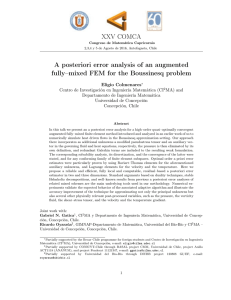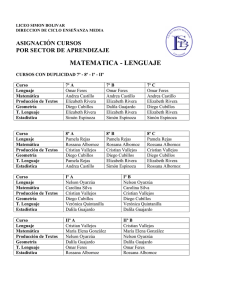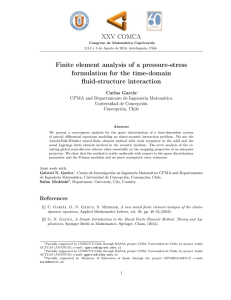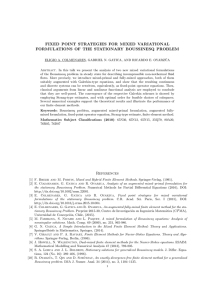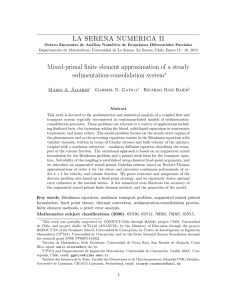XXV COMCA A priori and a posteriori error analysis
Anuncio
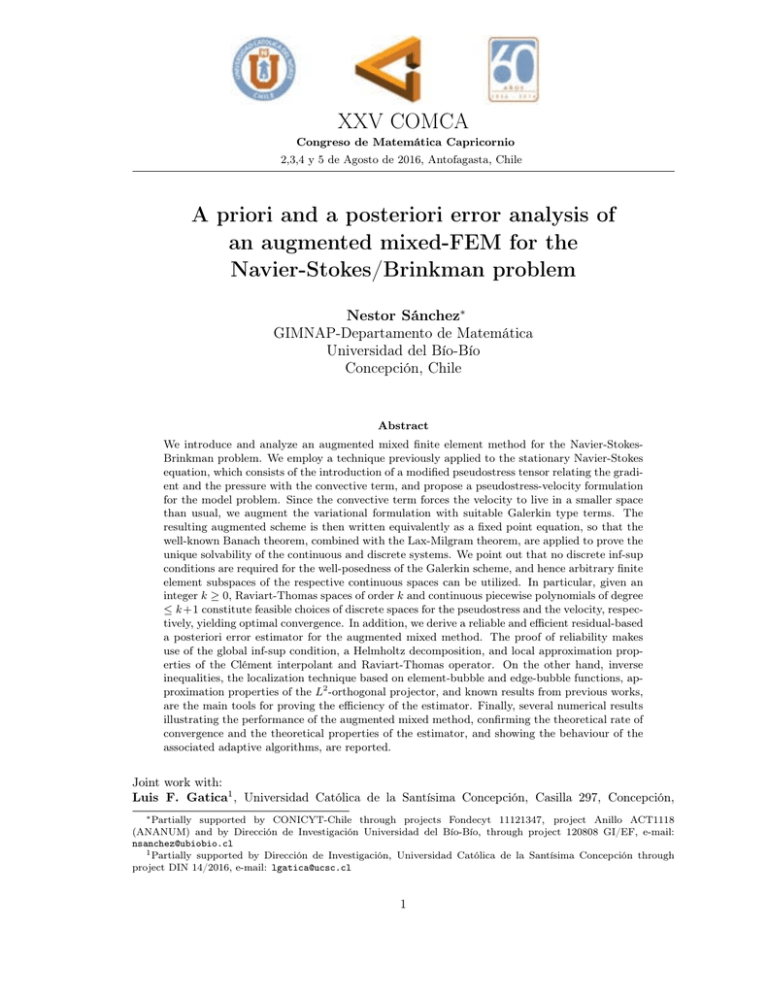
XXV COMCA Congreso de Matemática Capricornio 2,3,4 y 5 de Agosto de 2016, Antofagasta, Chile A priori and a posteriori error analysis of an augmented mixed-FEM for the Navier-Stokes/Brinkman problem Nestor Sánchez∗ GIMNAP-Departamento de Matemática Universidad del Bío-Bío Concepción, Chile Abstract We introduce and analyze an augmented mixed finite element method for the Navier-StokesBrinkman problem. We employ a technique previously applied to the stationary Navier-Stokes equation, which consists of the introduction of a modified pseudostress tensor relating the gradient and the pressure with the convective term, and propose a pseudostress-velocity formulation for the model problem. Since the convective term forces the velocity to live in a smaller space than usual, we augment the variational formulation with suitable Galerkin type terms. The resulting augmented scheme is then written equivalently as a fixed point equation, so that the well-known Banach theorem, combined with the Lax-Milgram theorem, are applied to prove the unique solvability of the continuous and discrete systems. We point out that no discrete inf-sup conditions are required for the well-posedness of the Galerkin scheme, and hence arbitrary finite element subspaces of the respective continuous spaces can be utilized. In particular, given an integer k ≥ 0, Raviart-Thomas spaces of order k and continuous piecewise polynomials of degree ≤ k +1 constitute feasible choices of discrete spaces for the pseudostress and the velocity, respectively, yielding optimal convergence. In addition, we derive a reliable and efficient residual-based a posteriori error estimator for the augmented mixed method. The proof of reliability makes use of the global inf-sup condition, a Helmholtz decomposition, and local approximation properties of the Clément interpolant and Raviart-Thomas operator. On the other hand, inverse inequalities, the localization technique based on element-bubble and edge-bubble functions, approximation properties of the L2 -orthogonal projector, and known results from previous works, are the main tools for proving the efficiency of the estimator. Finally, several numerical results illustrating the performance of the augmented mixed method, confirming the theoretical rate of convergence and the theoretical properties of the estimator, and showing the behaviour of the associated adaptive algorithms, are reported. Joint work with: Luis F. Gatica1 , Universidad Católica de la Santísima Concepción, Casilla 297, Concepción, ∗ Partially supported by CONICYT-Chile through projects Fondecyt 11121347, project Anillo ACT1118 (ANANUM) and by Dirección de Investigación Universidad del Bío-Bío, through project 120808 GI/EF, e-mail: [email protected] 1 Partially supported by Dirección de Investigación, Universidad Católica de la Santísima Concepción through project DIN 14/2016, e-mail: [email protected] 1 Chile,and CI2 MA, Universidad de Concepción, Casilla 160-C, Concepción, Chile. Ricardo Oyarzúa2 , GIMNAP-Departamento de Matemática, Universidad del Bio-Bío, Casilla 5-C, Concepción, Chile, and CI2 MA, Universidad de Concepción, Casilla 160-C, Concepción, Chile. References [1] J. Camaño, R. Oyarzúa and G. Tierra, Analysis of an augmented mixed-FEM for the Navier-Stokes problem, Mathematics of Computation, DOI: http://dx.doi.org/10.1090/mcom/3124 [2] S. Caucao, D. Mora and R. Oyarzúa, A priori and a posteriori error analysis of a pseudostress-based mixed formulation of the Stokes problem with varying density, IMA Journal of Numerical Analysis, vol. 36, 2, pp. 947-983, (2016). [3] G.N. Gatica, Analysis of a new augmented mixed finite element method for linear elasticity allowing RT0 − P1 − P0 approximations, ESAIM: Mathematical Modelling and Numerical Analysis, vol. 40, 1, pp. 1–28, (2006). [4] G.N. Gatica, A note on stable Helmholtz decompositions in 3D, Preprint 2016-03, Centro de Investigación en Ingeniería Matemática (CI2 MA), UDEC, (2016). [5] G.N. Gatica, L.F. Gatica and A. Márquez, Analysis of a pseudostress-based mixed finite element method for the Brinkman model of porous media flow, Numerische Mathematik, vol 126, 4, pp. 635-677, (2014). 2 Partially supported by CONICYT-Chile through projects Fondecyt 11121347 and 1161325, project Anillo ACT1118 (ANANUM) and by Dirección de Investigación Universidad del Bío-Bío, through project 120808 GI/EF, e-mail: [email protected] 2
